
NASA captures X8-class flare hits earth, disrupting radio communications
text_fieldsIn a spectacular display of celestial power, NASA's Solar Dynamics Observatory captured mesmerizing images of the most potent solar flare in six years.
The fiery flash on the sun's surface, classified as an X8-class flare, occurred on Thursday, sending ripples through Earth's atmosphere and causing a temporary disruption in radio communications.
The Solar Dynamics Observatory, a spacecraft launched by NASA in 2010, diligently monitors the sun's activity. Thursday's event, identified as a coronal mass ejection (CME), unleashed a burst of energy with the highest intensity, capable of affecting various aspects of our technological infrastructure.
The impact of the solar flare was felt for approximately two hours during daylight hours in some parts of the United States and beyond. The National Oceanic and Atmospheric Administration's space weather prediction centre described it as an "amazing event" and noted that it was likely one of the largest solar radio events ever recorded.
The interference with radio communications occurred between midday and 2 pm ET on Thursday, raising concerns about potential disruptions to electric power grids, navigation signals, and the safety of spacecraft and astronauts. Scientists are analysing the effects of the CME, which originated from the far northwest area of the sun.
This X8-class flare marks the strongest solar event since September 10, 2017, and stands out as the most powerful of the current solar cycle by a significant margin. Solar flares are typically graded between one and nine, with this event being classified as an X8.
For historical context, the European Space Agency recalled the most powerful solar flare ever recorded—an X28 event on November 4, 2003.






















